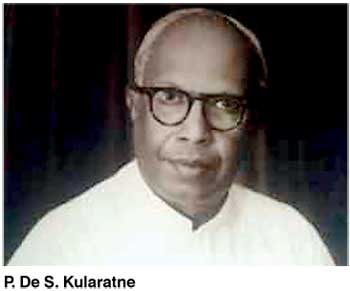Thursday Dec 12, 2024
Thursday Dec 12, 2024
Tuesday, 1 December 2015 00:02 - - {{hitsCtrl.values.hits}}
The first comprehensive English biography of this leading educationist will be launched on 3 December at 5:30 p.m. at Kularatne Hall, Ananda College, Colombo. Illustrious alumni Professor J.B. Disanayaka and Professor Sudharshan Seneviratne will provide their perspectives at the event.
Kularatne is best known as an outstanding educationist and is mainly remembered as the Principal responsible for developing Ananda College into a leading school. When he retired after 25 years, the College was not only synonymous with excellence but was widely recognised as a national institution with influence in many fields beyond the narrow confines of formal education.
P. de S. Kularatne was three months short of his 25th birthday when he took over as Principal of Ananda College on 1 January 1918. He arrived straight out of the University of London, having obtained three degrees in the space of four years, and had no experience in administration. At the time, even most of the Buddhist leaders felt that Ceylonese were not up to the task, and certainly not young men in their early twenties. However, the General Manager of Buddhist Theosophical Society schools, W.A. de Silva, made the inspired decision to put Kularatne in charge.
The atmosphere was politically charged. During the so-called Sinhala-Muslim riots of 1915 riots almost all the Buddhist leaders had been arbitrarily jailed by the British Government and they had been defended by Christian and Hindu community leaders. This solidarity among the different communities led to the formation of a national movement towards independence. In 1917 the Ceylon Reforms Congress (the precursor of the Ceylon National Congress) had been formed with Sir Ponnambalam Arunachalam as President and W.A. de Silva and F.R. Senanayake as Secretary and Treasurer respectively. (The Ceylon National Congress was subsequently founded in 1919.)
By 1918, the aims and aspirations of those managing Ananda had grown to recognise the crucial role that educational institutions should play in nation building. So Ananda was clearly intended to be a pivotal organisation in redressing the disadvantages faced by the vast majority in a country heading towards independence. Kularatne was expected to lead this campaign.
Kularatne’s vision of Ananda was broader and it was not merely to cope with externally-imposed circumstances, but to actively influence events. In that sense, Ananda was not now to be just a school, but a role model – an institution with a wider social and cultural dimension.
As Tarzie Vittachi, a student of Kularatne and a renowned journalist, would write later: “Ananda, for him, was a proving ground for his  vision of a free Lanka, a united, mentally and physically educated country whose way of life would be modulated by the broadmindedness of the Buddha and inspired by his rejection of superstition as an explanation of reality. His horizons were far beyond Maradana Road and Kuppiyawatta.”
vision of a free Lanka, a united, mentally and physically educated country whose way of life would be modulated by the broadmindedness of the Buddha and inspired by his rejection of superstition as an explanation of reality. His horizons were far beyond Maradana Road and Kuppiyawatta.”
Ananda, the most prominent Buddhist school in colonial Ceylon, still had less than 500 students after over 30 years of existence. But in a few years he, together with a band of inspired teachers, supporters and benefactors, transformed Ananda into a pre-eminent national institution with influence far beyond traditional education. All this was achieved with meagre financial resources, a generally unsupportive (and sometimes obstructive) Government and during a period of intense political ferment. How he managed this transformation is detailed in “Kularatne of Ananda”.
Kularatne also fostered good relations among different social and religious groups. He welcomed teachers and students from all communities to teach and study in an atmosphere free of religious compulsion. He had cordial relations with Richmond College, Galle and Wesley College, Colombo where he was educated. When T.B. Jayah, a senior teacher at Ananda, was invited in 1921 to become Principal of Zahira College, Colombo and revitalise it, Kularatne not only seconded teachers from Ananda to help him but also some students.
His subsequent political life was dedicated to the movement to expand educational opportunities to the disadvantaged throughout the country and he played a leading role in the free-education movement. He was an active participant in higher education when the University of Ceylon was established and was instrumental in creating a Chair for Sinhala in the university.
Although Education Policy and its implementation dominated his politics, he contributed in many other areas too. For instance, he initiated the Commission that led to the formation of the Employees’ Provident Fund and was responsible for much of the urban infrastructure of modern Ambalangoda. His contributions to these other sectors have received little publicity and, in some instances, the credit due to him has gone to others.
There is at present no definitive account of the part played by Kularatne and Ananda College in the nationalist movement of the 20th century. The large amount of primary material unearthed while researching into the life of Kularatne is very illuminating. Such information often gets lost in the writing of a biography. Therefore, in this work, every iota of valuable information was retained and specifically woven into the narrative. This book can be read as a biography and also as a study on selected aspects of British rule in Sri Lanka.
(Author Kamalika Pieris studied Sociology at University of Ceylon and obtained the Postgraduate Diploma in Librarianship from University of London. She has held positions as librarian in the International Planned Parenthood Federation, Indian Ocean Regional Office, Colombo, Sri Lanka National Library Services Board, National Institute of Business Management, Postgraduate Institute of Medicine and Sri Lanka Institute of Architects. Her publications include Medical profession in Sri Lanka 1843-1980; Bibliography of medical publications relating to Sri Lanka 1811-1976; Bibliography on urban Sinhala theatre 1867-1986; and Sinhala cinema 1948-1986.)